DigiTech RP Multi-Effect Pedals
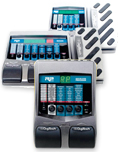
DIGITECH'S RP SERIES of multi-effects pedals have already proven themselves to over one million guitarists. Like Goldilocks and the three bears, the RP series has been enhanced with the arrival of three new processors, and the chances are very good that one of these will be just right for your jamming, gigging, and recording needs.
COMMON FEATURES
All three processors function in three different modes-Performance, Bypass, and Tuner. Performance mode features simple up/down pedals to scroll through presets, rather than the complicated banks and sub-groups used by so man y of today's modeling pedals. Customizing a preset can be as simple as a twist of three knobs. "Tone Library" (the first knob you'll find on all three RP pedals) essentially selects what you'd expect to find in the front half of your signal chain. It includes amp models and effects like distortion, compression, and noise gates in 30 presets with names like "Rock 1," "Rock 2," "Smooth," and "Chunky." Then, by using the "Effects Library" knob you can call up one of 30 different post-amp model effect chains such as "Chorus," "Flanger + Analog Delay," or "Pitch + Digital Delay" to add the appropriate color to your tone. The third knob, "Effects Level," adjusts the amount of effects to taste. Deeper editing is possible with up/down buttons and the easy-to-understand LED-illuminated effects matrix, or by using the downloadable X-Edit editor librarian software and two-in, two-out USB port.
"We designed these new RP processors with four levels of user interface in mind," says Digitech's David Rohrer. "First, there's the simple scrolling up and down through the presets, which will satisfy many players. Then there's the use of the Tone and Effects Library knobs, which is like splitting your signal chain in half and editing either the front or the back half. In the past you'd have to go into deep editing to access these possibilities. Then there's the deep editing, where specific effects and models can be turned on or off, and individual parameters of individual effects can be set, and finally the X-edit Librarian computer-editing capabilities." All three units come standard with 60 pre-programmed drum patterns, easily engaged with the front-panel "Drums" button. A chromatic tuner with dropped options is also standard, as is five seconds of delay time. Jacks common to all three models include left (mono) and right 1/4" outputs with amp/mixer optimization, and a 1/8" stereo headphone jack; with the USB port, each unit can double as a guitar-to-computer interface for digital recording. And all three pedals are built like tanks, with firm, secure pedals and knobs in a rugged cast-metal chassis.
SOUNDS
In terms of quality and complexity of sound, all three pedals are packed with identical firepower, thanks to Digitech's AudioDNA2 chip (see sidebar). Up to 11 amp models, distortions and effects can be chained together in one patch, and the only difference is in the quantity of models-the RP150 has 77, the RP250 has 89, and the RP350 has 118. You'll find all the classics here-Tube Screamer, Big Muff, Crybaby, Uni-Vibe, even Lexicon reverb, as well as a healthy portion of Digitech offerings, of course. Amp models include American and British rigs in both classic and modern incarnations. I was immediately impressed with the range of practical sounds from these processors. There are crystal clear, direct-into-the-board settings that sparkle with chorus and subtle delay, and there are raging, dragged-through-the-mud stack simulations. Snarling Texas blues patches exist beside '80s arena-rock sounds; smoky jazzbo tones can turn a single-coil axe into a hollowbody box. Digitech has always had a great ear for powerful bottom end, and this trio of processors delivers chunk and roar aplenty. Likewise, Digitech's ambience and digital delay models are outstanding for their airiness and clarity. The pitch shifting and harmonization effects are superb, and there are even a few alien robot and synth sounds aboard.
RP150
The RP150 packs a lot of wallop into its modest package. 77 models (48 effects models, 17 amp/preamp/ acoustic guitar models, and 12 speaker cabinets) are available for the 50 user and 50 factory presets. The two footswitches, four buttons, and four knobs make the RP150 interface extremely user-friendly. The display is limited to a two-character LED, however, which might discourage onthe- fly editing. Don't be put off by the lack of an expression pedal, by the way-there's a "Control In" connector that will let you pump away at Wah, Whammy, and Volume parameters if you add your own outboard expression pedal.
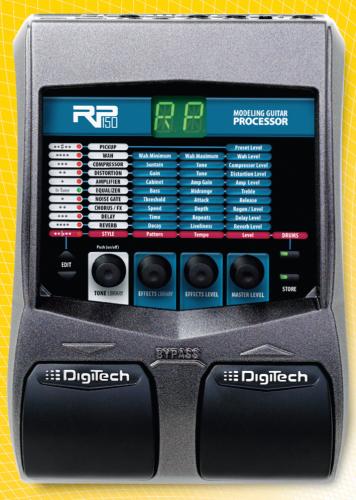
RP250
Digitech ups the ante with 89 models (54 effects, 21 amp/preamp/acoustic guitar models, and 14 speaker cabinets) within the RP250. Users can store up to 60 user presets along with 60 factory presets. Perhaps the two most important upgrades are the integral metal expression pedal for wah, whammy, and volume manipulation, and the six-character LED display, which greatly enhances patch identification and editing chores. There's also an auxiliary 1/8" stereo input for plugging in your iPod or CD player.
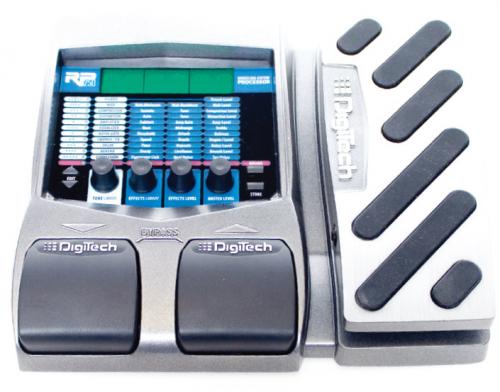
RP350
The RP350 features 118 models (73 effects, 27 amplifier/preamplifier/acoustic guitar models, and 18 speaker cabinets) stored in 70 factory presets and 70 user presets. Many of the RP350's expanded features focus on the amp-modeling and switching functions, such as two additional knobs that give immediate control over amplifier gain and level, and the additional footpedal that functions as an amp A/B footswitch for the selected preset. That means that for every preset, you now have two amps to choose from, an excellent option for live performance when you want to toggle between, say, a clean setting for the verse and a heavy distortion for the chorus while retaining ambient effects like reverb and delay. The back panel of the RP350 also enhances performing and recording options with a pair of direct injection-friendly XLR outputs, and the six-character, two-digit LED display provides plenty of visual feedback on the darkest stage. By the way, the third footpedal also adds Digitech's Learn-A Lick feature: up to 10 seconds of audio from the auxiliary input can be captured, looped, and played as slowly as 1/4 speed without changing pitch, a simple and effective way to pick up phrases from those terrifying shred-masters.
Get The Pick Newsletter
All the latest guitar news, interviews, lessons, reviews, deals and more, direct to your inbox!
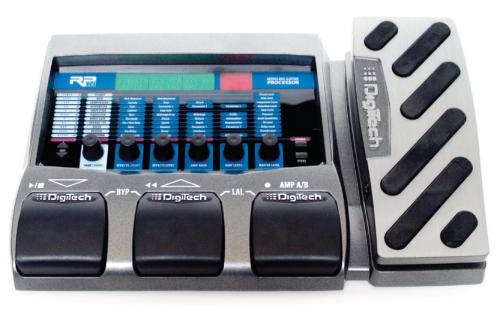
IS IT FOR YOU?
One million guitarists can't be wrong. Digitech's RP series is well known for an easy user interface and truly robust processing, and the RP150, 250 and 350 make the interfacing even easier (via the Tone Library and Effects Library knobs) and the processing even more powerful. The modeling is spot-on, often subtly inspiring, and you may never need to go any deeper into editing than choosing the factory presets and tweaking the Tone and Effects Library knobs. While all three units deliver exceptional value, we feel the RP150 is truly outstanding for its simplicity, range of sounds, and portability, not to mention its price point. Welcome, RP150, to the "1 Award" club.
FEATURES
All three processors share the following: Tone Library, Effects Library and Effects level editing knobs Simple up/down patch access Mono/Stereo outputs 60 drum patterns USB ports RP150: 77 models, 50 user/50 preset patches RP250: 89 models, 60 user/60 preset patches, expression pedal RP350: 118 models, 70 user/70 factory preset patches, expression pedal, amp A/B switching, and XLR outputs
SIDEBAR: Genetic Engineering
At the heart of the new RP series is the proprietary AudioDNA2 digital signal processor, four times as powerful as the previous AudioDNA processor. The AudioDNA2 is a proprietary chip cooked up exclusively by Digitech and designed specifically for audio processing. I spoke at length with Digitech's David Rohrer about the benefits of the AudioDNA2 chip. "It's important to understand that this is not an offthe- shelf chip, like something you'd find in a telephone or a car dashboard. The AudioDNA2 chip was designed only for audio processing," notes Rohrer. "Furthermore, it provides even greater accuracy, authenticity, and dynamics than the earlier AudioDNA processor. You'll hear it in subtleties of dynamic response, in direct comparison of our amp models to their vintage counterparts, and in things like how an amp model cleans up when you drop your guitar's volume."
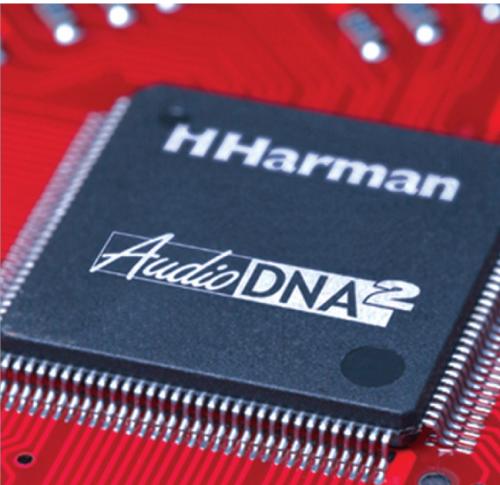
Did any of the other Digitech lines influence the upgrades in the RP modeling processors? "Absolutely. We learned a lot when we developed the Artist Pedals, for example. Working with talents like Brian May [for the Red Special pedal] and [engineer] Eddie Kramer for the Jimi Hendrix Experience pedal gave us some deep insight into capturing the essence of great tone. That kind of focus on tonal sculpting went into these new RP pedals. And it's not just the guitar-processing tones that reap the rewards of AudioDNA2. It's been used to enhance the drum samples used in the RP's built in drum machine as well," says Rohrer.










